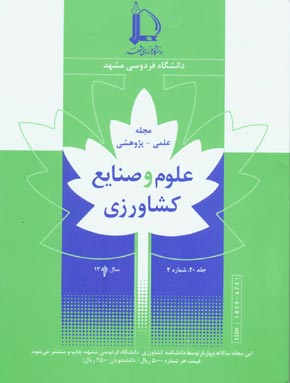فهرست مطالب
نشریه علوم و صنایع کشاورزی
سال بیست و یکم شماره 1 (پیاپی 46، نیمه اول 1386)
- حفاظت نباتات
- تاریخ انتشار: 1386/01/11
- تعداد عناوین: 7
-
-
کنترل بیولوژیکی قارچRhizoctonia solani عامل مرگ گیاهچه کلزا با استفاده از Bacillus subtilis و. Streptomyces spصفحه 3In this study, one hundred and thirty seven bacterial isolates were collected from canola root and rhizosphere in Golestan, Mazandaran, Guilan and Tehran provinces. At first, antagonistic effect of bacterial isolates on Rhizoctonia solani was studied using dual culture test assay. The results showed that 29 isolates had the ability to inhibit the growth of fungi on PDA medium. On the basis of the biochemical, physiological and morphological tests, the isolates B1 and B2 were identified as Bacillus subtilis and S1 as Streptomyces sp.. Results of the studies on biocontrol mechanism showed that isolates produced antibiotics that prevented the mycelial growth of the fungus. Also the isolates produced some antimicrobial metabolites including protease and siderophore. Isolate B1 had the greatest inhibitory effect in vitro growth of the fungus. The effect of isolates on disease reduction in comparison to control has significanly differentiated. None of the isolates were able completely to prevent disease occurrence. Application of soil treatment had a significantly higher disease control as compared to seed treatment. Isolate B1 had considerable effect on reduction disease under the greenhouse conditions. Also all isolates were capable of colonizing canola roots and increasing canola growth in free-causal agent conditions.
-
صفحه 4Whiteflies (Homoptera: Aleyrodidae) have endosymbiotic organisms, Gamma subdivision of theclass Proteobacteria, in their digestion system. These organisms have important role in survival and reproduction of their hosts, therefore the ultrastructure of them was examined in Bemisia tabaci ennadius, using transmission electron microscopy. Two types of microorganisms were observed in mycetocytes. The predominant type lacked a distinct cell wall, was pleomorphic in shape with a surrounding vacuole. The second type was a convex organism, with the distinct cell membrane, and often found in group of varying number within vacuoles. Different populations of B. tabaci were collected from Isfahan, Fars, Kerman, Tehran, Khorasan, and Azarbayjan provinces for studying of the correlation between mycetocyte morphological variation and populations or biotypes of B. tabaci. B. tabaci individuals from Isfahan, Fars, and Kerman contained two morphological types of microorganisms. In contrast, individuals from populations of Tehran, Khorasan, and Azarbayjan consistently contained three distinct morphological types of microorganisms within their mycetocytes. Since the third type of microorganisms are present only in A biotype of B. tabaci, and B biotype contains only two of mentioned microorganisms. Biotype B of B. tabaci which is more destructive than the A one, exists in Isfahan, Fars, Kerman, and probably other southern regions of Iran.
-
صفحه 17Based on host range distribution of fungus Verticillium dahliae and its survival on various weeds, and determination of the fungus, symptom on weed and pathotypes and comparison to symptom on cotton could clear the status of such host to be considered for pathogenicity tests and their susceptibility. Pigweed (Amaranthus retroflexous) is an important weed of cotton field and olive orchard, and also susceptible to fungus Verticillium dahliae. In this study, effects of defoliate and nondefoliate isolates on pigweed were similar. First symptoms of disease development in pigweed, observed 20 days after inoculation. But, in cotton the first symptom of disease was observed 30 days after inoculation. Disease symptom of fungal isolates collected from olive trees appeared as defoliate on pigweed but induced chlorosis associated with wilting in cotton. Only G1 isolate from cotton caused seedlings decline of cotton and pigweed. Disease severity of cotton isolates were less on pigweed than cotton plant. Means of colony growth rate of fungal isolates were significantly different by range of temperatures (23, 25, 27, 29°c) which seperated them from each other. Isolates B1, D3, F3 showed more than 50% severity on cotton and only 50% on pigweed. But isolates of G1, G2, and G5 showed disease severity 75-100% on cotton and 8.3-100 on pigweed respectively. There was variation in shape and size of microsclerotia in different isolates.


